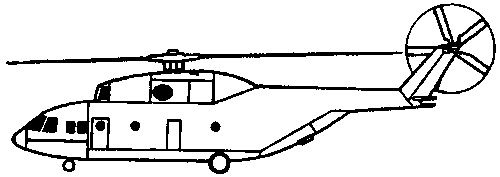
| Mil Mi-46 project |  |
 |

| Mil Mi-46 project |  |
 |
|
Project to replace Mi-6 (Mi-46T) and Mi-10K (Mi-46K). Modern design, just over half weight of Mi-26, 7-blade rotor, 5-blade tail rotor. Mi-46T with layout similar to Mi-26 with unobstructed hold with rear ramp door, twin engines and oil cooler ahead of main gear-box, fixed twin-wheel tricycle landing gear. Mi-46K flying crane similar to Mi-10K with stub wings, long braced landing gear, aft-facing pilot position used when picking up or setting down. Bill Gunston "The Osprey Encyclopedia of Russian Aircraft", 2000
Mi-46T TYPE: Twin-turboshaft passenger/freight transport helicopter. PROGRAMME: Project announced summer 1992; no further announcements. DESIGN FEATURES: Replacement for Mi-6, with T-O weight just over half that of Mi-26. General configuration similar to Mi-26; seven-blade main rotor, five-blade tail rotor; non-retractable tricycle landing gear with twin wheels on each unit; few windows in hold; rear-loading ramp and doors; engines above hold, forward of main rotor driveshaft. POWER PLANT: Two new-type Aviadvigatel turboshafts, each 5,590 kW (7,495 shp). ACCOMMODATION: Equipped normally to carry freight. Mi-46K TYPE: Twin-turboshaft flying crane helicopter. PROGRAMME: Project revealed summer 1992; no subsequent announcements. DESIGN FEATURES: Replacement for Mi-10K, of typical large flying crane configuration, utilising fuselage nose, flight deck, power plant and dynamic components of Mi-46T; flat-bottomed, shallow centre and rear fuselage, with short stub-wings and long tripod-braced mainwheel units; glazed gondola for second pilot, facing rearward behind front fuselage pod, to control helicopter during loading and unloading. Sling cable directly under main rotor driveshaft for payload. POWER PLANT: Two unspecified 5,965kW turboshafts. Jane's Helicopter Markets and Systems
|